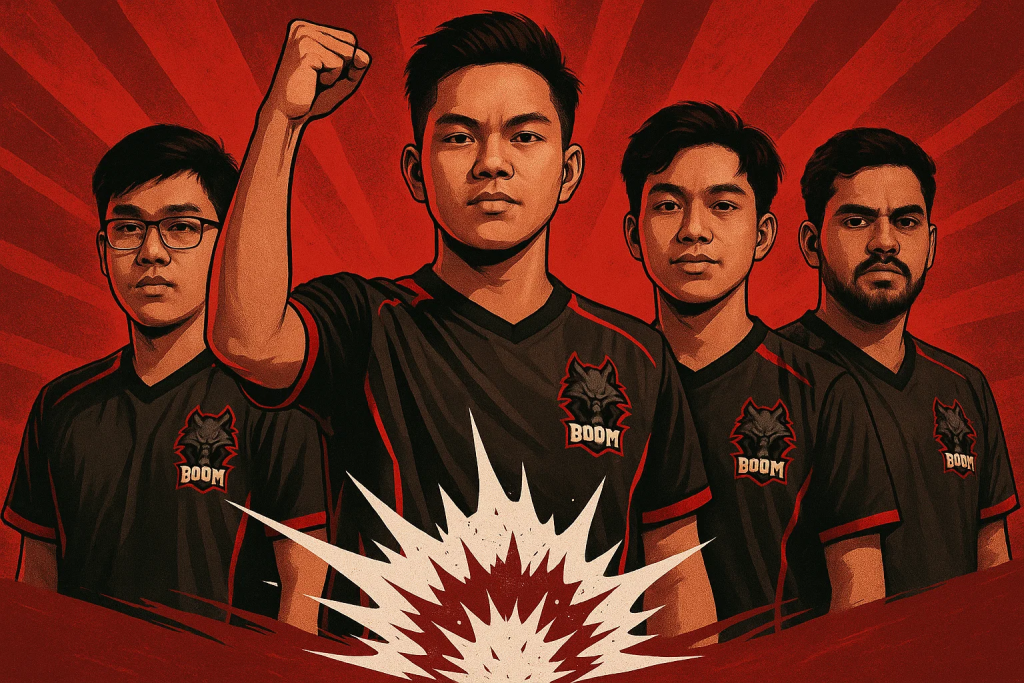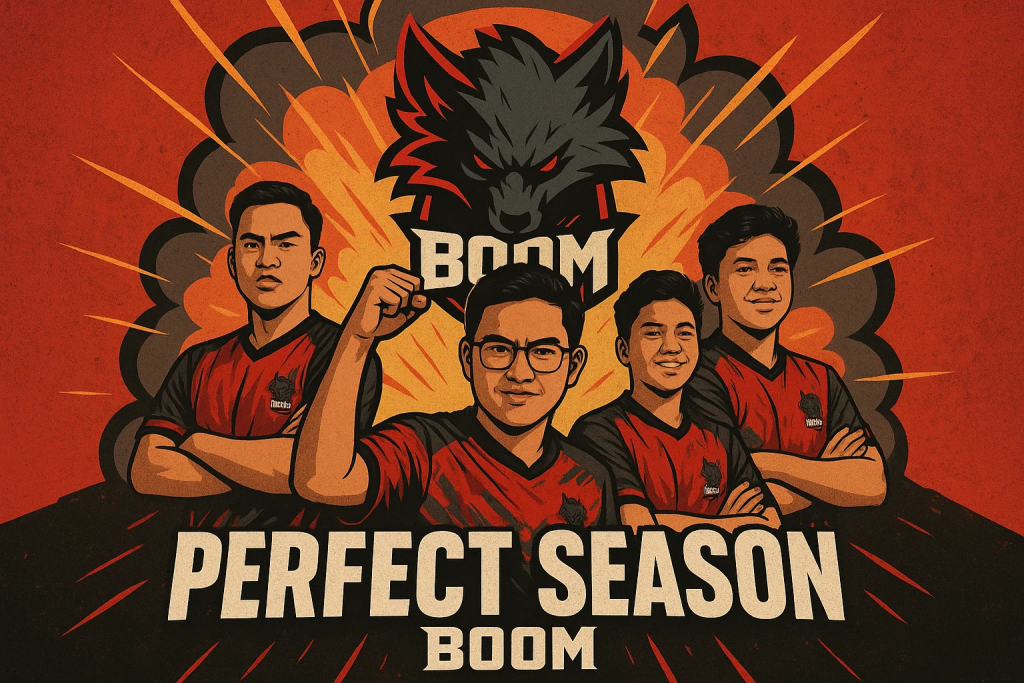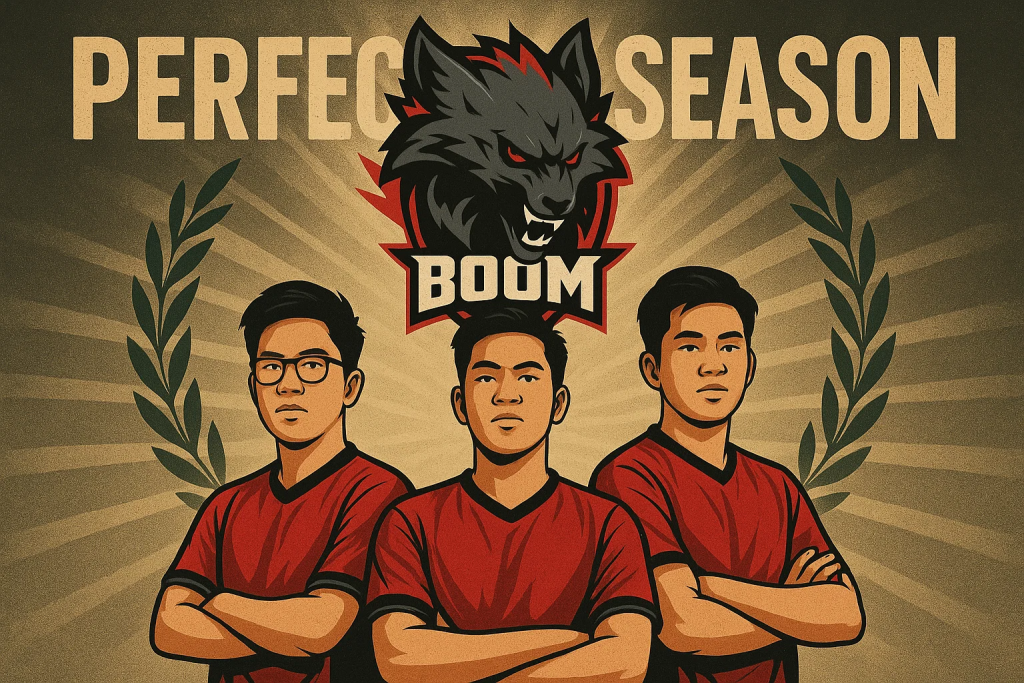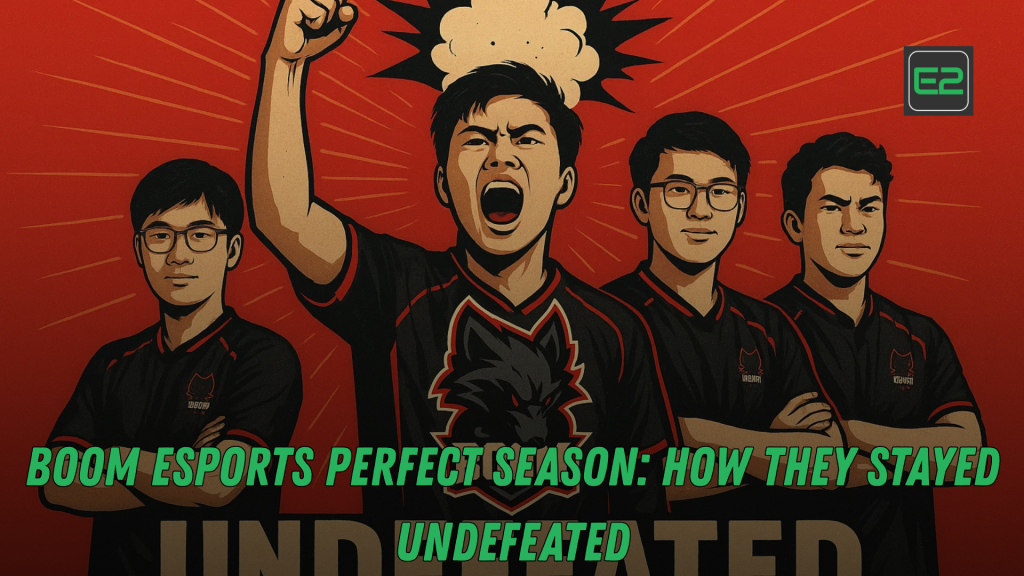Table of Contents
BOOM Esports: In competitive esports, perfection is a myth—until a roster makes it real. This is the story of how an organization built the culture, systems, and in-game discipline to run the table from opening week to the trophy lift. We’ll break down strategy, staffing, practice design, mental resilience, analytics, and brand execution so you can understand what it really takes to go from strong to unstoppable.

Executive Summary
- Relentless fundamentals beat flashy heroics when pressure is highest.
- Data-driven draft prep narrowed chaos into repeatable advantages.
- A clear identity—tempo, map control, and objective priority—simplified decision-making.
- High-return practice loops favored quality over grind.
- Support staff, from analysts to performance coaches, compounded marginal gains.
- Culture and communication converted good days into great weeks—and great weeks into history.
If you remember only one line, remember this: BOOM Esports perfect season was not an accident; it was engineered through hundreds of small, correct decisions.
The Foundation: Culture That Compounds
Championship runs start years before the bracket. The organization put player discipline and psychological safety at the center. That meant transparent expectations, calm VOD review rooms, and zero-ego debriefs. Veterans mentored newcomers without gatekeeping, and leadership framed mistakes as data, not drama. When pressure spiked, that culture converted nerves into focus.
Shared Language
Micro calls were standardized. Words like “contest,” “stall,” “reset,” and “swing window” carried specific timing and geometry. Because everyone internalized the same dictionary, mid-fight pivots were faster and cleaner than opponents expected.
Accountability Systems
After every scrim block, players completed short self-reports: confidence level, energy level, personal goal adherence. Coaches mapped responses to performance. A pattern of low energy on day three of practice led to program changes, not blame.
Identity First, Strategy Second
The squad built a clear identity: control early tempo, deny enemy power spikes, and race to objective advantages. Drafts reinforced that identity instead of chasing trends. The result looked inevitable on broadcast: BOOM Esports perfect season started in the draft lobby long before the lanes.
Draft Blueprints
Rather than memorizing dozens of counters, the staff prepared “blueprints”—three to four compositional families that could be adapted to meta changes. Each blueprint had:
- Anchor picks with consistent lane outcomes
- A proactive tool for early skirmishes
- A scaling insurance policy
- A fallback wave-clear plan if tempo stalled
By training decision trees instead of one-off counters, the team navigated patch turbulence with minimal drop-off.
Win Conditions by Minute Mark
Segmented goals turned maps into sprints: minute three first wave control, minute five vision line upgrade, minute eight first objective, minute ten reset and item spike alignment. Players could sense ahead or behind states without coach prompts, which removed hesitation in chaotic fights.
Practice That Produces Skill, Not Just Hours
Scrim volume impresses social media; skill acquisition impresses the standings. The staff replaced “play until tired” with targeted, measurable drills. That’s a central reason BOOM Esports perfect season became possible.
- Constraint-led customs: Disable common comfort picks to force adaptability.
- Deliberate review: Clip only three moments per player per map; attack root causes, not symptoms.
- Cue training: Teach visual and audio cues that reliably predict enemy intentions.
- Fatigue caps: Protect mechanical precision by limiting low-quality late-night blocks.
The 3–2–1 Review Model
- 3 team moments that defined momentum
- 2 individual sequences per player to fix this week
- 1 cultural reinforcement (e.g., “we praise early comms even if the call is imperfect”)
This cadence kept reviews short, focused, and emotionally safe.
Analytics Without Overwhelm
The analysts pointed data at decisions that matter. Instead of flooding players with spreadsheets, they turned numbers into choices: ward here, contest there, swap now. That translation layer converted analysis into wins—and supported the aura that fuels a streak like the BOOM Esports perfect season.
Dashboard Highlights
- Tempo differential: Average seconds ahead on first objective setup
- Resource parity: Gold and XP gap rules that dictated whether to trade or fight
- Cooldown windows: Automated pings for enemy ultimate and summoner spell timers
- Draft EV: Expected value of specific pick/ban sequences based on scrim and stage data
Communication: Crisp, Calm, Consistent
When games tilted, comms got simpler, not louder. Shot-calling compressed to short verbs (“stack,” “peel,” “force,” “skip”). Information hierarchy kept the channel clear: the player with the next actionable cooldown spoke first; the player tracking the macro timer framed the plan second; everyone else clipped in with confirmations.
Tilt Immunity by Design
The captain enforced a two-rule reset after mistakes:
- State the fact (“we lost mid flash and wave 3”).
- State the plan (“give river, trade top plate, buy time for six”).
No sarcasm, no sighs, no spiral.
Patch Management and Meta Foresight
Champions rise and fall; habits endure. The staff ran small “patch labs” forty-eight hours after notes dropped. The goal wasn’t to be first at everything—it was to be right at the two or three changes that matched their identity. That’s how BOOM Esports perfect season sustained even when balance shifted.
Pick/Ban Discipline
Being undefeated doesn’t mean winning every lane; it means refusing low-percentage ego picks on stage. The coaches empowered star players to say, “Not today,” and saved spicy looks for scrims. Swagger is for content; stage time is for certainty.
Fitness, Sleep, and Focus
Performance isn’t magic; it’s biology. The team adopted evidence-based routines: morning sunlight exposure, caffeine curfews, and breathing drills between maps. Mechanical precision and decision speed both improved, protecting the edges that make the BOOM Esports perfect season narrative possible.
Travel Routines
Away weeks can tank form. The operations lead standardized travel kits (light blockers, earplugs, mini-routers, resistance bands) and preset meal plans to reduce variability.
The Coaching Stack
Head coach, assistant coach, analyst lead, position coaches, and a performance specialist each owned a slice of the pie. Clear lanes prevent turf wars—and accelerate feedback. That structure turned close maps into confident closes, the hallmark of the BOOM Esports perfect season.
Role of the Captain
The captain was the human bridge between plan and play. In scrims, they argued. On stage, they executed. That duality preserves creativity while ensuring clarity when it counts.
Map Control as a Habit
Audiences love highlight reels; champions love vision control. Every practice block tracked ward lifespans and sweep timings. Rotations formed around information, not hunches, which is a quiet reason the BOOM Esports perfect season stayed intact through late-game stress.
Objective Priority, Not Kill Chasing
When a skirmish didn’t serve Baron, Dragon, or towers, the team passed. Boring is underrated. Scoreboards lie; structures tell the truth.
Adaptation Without Identity Drift
The team iterated constantly, but never abandoned its core. That tension—stable identity with flexible execution—allowed the BOOM Esports perfect season story to reach the finish line without a late collapse.
Anti-Snowball Protocols
Down early? The team had scripts: cut losses, trade cross-map, starve vision, wait for the one high-odds fight. Comebacks weren’t chaos; they were rehearsed.
Brand and Fan Engagement
Undefeated seasons are sport stories, but they’re also brand flywheels. Content beats magnified the streak, turning casual viewers into community advocates. This external momentum fed internal confidence, reinforcing the BOOM Esports perfect season dynamic.
Content Cadence
- Instant reactions after wins—controlled, humble, repeatable
- Behind-the-scenes clips from review rooms and practice spaces
- Explainer threads where analysts demystified draft theory
- Community challenges that rewarded fan analysis and memes
What Other Teams Can Borrow This Week
You can’t copy a roster, but you can copy a process. If you want your own version of the BOOM Esports perfect season, start small and iterate:
- Define your identity in one sentence.
- Build two draft blueprints that serve that identity.
- Run 3–2–1 reviews after every map this week.
- Standardize five micro-call verbs and stick to them.
- Create a simple tempo differential dashboard.
- Protect sleep and cut scrim blocks before mechanics decay.
Common Pitfalls—and How to Dodge Them
- Over-analysis paralysis: Limit pre-match notes to one page.
- Meta chasing: If a pick doesn’t fit your identity, it’s bait.
- Hero ball: Shot-calling is a system, not a solo.
- Toxic reviews: Attack decisions, not people.
- Volume worship: Five focused scrims beat ten unfocused ones.
Case Study Snapshots
- Clutch mid-game call: Faced with a lost river fight, the team traded opposite side objectives and reset on tempo. That swing avoided tilt and preserved the BOOM Esports perfect season.
- Draft trap avoided: A crowd-favorite comfort pick was open; they passed to maintain objective control tools, a boring choice that won later.
- Travel week execution: Despite jet lag risk, standardized routines kept mechanics crisp and the BOOM Esports perfect season thread unbroken.
The Psychology of an Unbeaten Locker Room
Confidence compounds, but only when moored to habits. Players were encouraged to celebrate behaviors (clear comms, early setup) rather than outcomes (kills). That framing made the BOOM Esports perfect season emotionally sustainable across the split.
Pressure Alchemy
Before marquee matches, the staff rehearsed “pressure scripts”: visualizing worst-case starts and practicing first-five-minute stabilizations. Fear shrank; options expanded.

Lessons for Coaches, Players, and Analysts
- Coaches: Teach decision trees, not pages of counters.
- Players: Master your first three minutes. So much snowballs from there.
- Analysts: Translate data into two or three binary choices per stage day.
- All: Protect culture like it’s a win condition—because it is. That’s the only way a storyline like the BOOM Esports perfect season survives the grind.
SEO Corner: Why This Story Matters Beyond the Hype
Searchers aren’t only looking for who won; they’re asking how to replicate excellence. By structuring this guide around identity, practice design, analytics, and culture, we give team staff and ambitious amateurs a blueprint to improve next week, not next year.
Tactical Deep Dive: Early, Mid, and Late Game
Early Game Principles
The team’s early game wasn’t about coin-flip invades; it was about slowly strangling options. Jungle pathing prioritized information first, punish second. Side lanes aimed for wave states that opened roam windows rather than risky solo kills. Support roamed on timers, not vibes. Small edges stacked into tempo, and tempo turned into dragon and herald control. That is the boring backbone of the BOOM Esports perfect season.
Mid-Game Conversion
Mid game is where vision wins. The team’s default was to place deep wards on exits, not entrances, then force opponents to face-check on a clock. If enemies stalled, lane assignments shifted to create 1-3-1 or 4-1 pressure patterns depending on comp. Shot-calling compressed to essential verbs: “push,” “hover,” “trade,” “force.” When a pick appeared, the kill became a means to an end—towers and Nash, never just a montage. That discipline maintained the BOOM Esports perfect season in maps that looked scary for two minutes but…
Late Game Insurance
Late games were approached with humility. Even while ahead, the team respected enemy win conditions. They tracked timers, avoided coin-flip barons, and waited for vision denial to finish the job. When a throw risk appeared, they cut losses and re-set waves. Insurance, not hubris, kept the BOOM Esports perfect season from unraveling in week seven fatigue.
The Weekly Training Blueprint
Monday – Identity Reset & Mechanics
- Morning: 90-minute mechanics block (aim, movement, ability drills).
- Afternoon: Two targeted scrims on draft blueprint A.
- Evening: Short VOD review (3–2–1 model), sleep by midnight.
Tuesday – Draft Lab & Matchups
- Morning: Draft ideation and counter trees.
- Afternoon: Three scrims with forced weak-side lanes to sharpen crisis play.
- Evening: Breathing practice and visualization; journaling on focus cues.
Wednesday – Information Day
- Morning: Analyst classroom on scout reports; tempo and resource parity case studies.
- Afternoon: Two scrims with explicit objective timers called by non-IGL players.
- Evening: Device-off wind-down; nutrition and light mobility work.
Thursday – Patch Foresight & Flex Picks
- Morning: Patch lab experiments with a 60-minute limit.
- Afternoon: Three scrims mixing blueprint A/B; test one flex curveball.
- Evening: Review only wins and losses for confident pattern recognition.
Friday – Stage Simulation
- Morning: Routine walk-through (arrive, warm-up, tech checks).
- Afternoon: Two scrims with stream delay and stage comm protocol.
- Evening: Early bedtime; no ranked queues.
Weekend – Matches & Active Recovery
- Stage days run on autopilot; post-match recovery emphasizes gentle movement, hydration, and one non-game social activity to keep the room human. These rituals, more than hype speeches, are why the BOOM Esports perfect season didn’t buckle under spotlight and schedule pressure.
Scouting and Recruitment
Undefeated seasons start in tryouts. The org weighted decision-making speed, communication style, and tilt profile as heavily as raw mechanics. Trial blocks mixed comfort and discomfort conditions to reveal adaptability. Staff evaluated “learning velocity” in addition to current form, the hidden trait behind the BOOM Esports perfect season.
Role Fit Over Star Aggregation
It’s tempting to stack five aim gods. Instead, the org built overlapping strengths with minimal redundancy. When everyone can do everything, no one owns the crucial tasks. When roles are clear, timing is crisp, and the BOOM Esports perfect season story writes itself one efficient map at a time.
Scrim Partner Strategy
Scrim partners were chosen like sparring partners: some to push mechanics, others to sharpen macro. The staff tracked scrim translation rate—how often a scrim scenario reappeared on stage. Low-translation partners were rotated out. That ecological view of practice quality protected the BOOM Esports perfect season from empty mileage.
VOD Prep Workflow
- Collect: Analysts tag timestamps using consistent taxonomies (setup, contest, reset, trade).
- Curate: Coaches pull five clips per opponent that match the team’s blueprint triggers.
- Compress: A 25-minute pre-match VOD replaces hour-long lectures.
- Connect: Each clip ties to a single actionable “if X, then Y” rule. Players walk away feeling lighter, not heavier—critical to sustaining the BOOM Esports perfect season.
KPI Stack: What Actually Moved the Needle
- First objective control rate above 65% across the split
- Vision denial uptime over key corridors at 58%+
- Neutral objective deaths under 3% of attempts
- Enemy cooldown tracking accuracy above 80% in comm logs
- Reset discipline: sub-40 seconds average team desync time
None of these stats trend on social media, yet they form the scaffolding of the BOOM Esports perfect season.
The Future: Sustaining Dominance Without Stagnation
Dynasties die when they mistake stability for stasis. The staff schedules “curiosity sprints” each offseason—two weeks where players explore new roles, new champions, or new games entirely to refresh mental models. The goal isn’t to change identity; it’s to expand the palette. That curiosity keeps the BOOM Esports perfect season from becoming a prison.
A Playbook You Can Start Today
- Write your identity on a sticky note. If it needs two sentences, tighten it.
- Audit your comms. Pick five verbs and remove filler.
- Replace one scrim block with a drill block that targets a single weakness.
- Build a tiny dashboard: tempo differential, objective control, reset discipline.
- Run an honest retro: which habits helped last week, which hurt?
Small steps, repeated, produce big arcs—the same arc that culminated in the BOOM Esports perfect season.
Glossary for Newer Fans
- Tempo: The initiative to act first, forcing reactions.
- Reset: Team returns to base to sync items, health, and wave states.
- Trade: Giving up one objective to take another of equal or greater value.
- Face-check: Walking into fog of war without vision.
- Blueprint: A flexible draft family that encodes identity.
Understanding these terms helps you see the invisible chess that underpins the BOOM Esports perfect season.
Call to Action
If you lead a team, take one idea from this guide and ship it this week. If you’re a fan, watch the next match with a notebook: track vision, resets, and objective timing. Share your observations, debate respectfully, and build the community literacy that lifts the whole scene. Excellence scales when knowledge spreads—and that’s how we get more chapters like the BOOM Esports perfect season.
This guide favors clarity, brevity, and repeatable action.

Conclusion: Excellence Is a System
Perfection is not luck. It is the compounding result of identity clarity, draft discipline, practice science, and calm communication. If you apply even a fraction of these principles, your results will tilt upward—and you’ll understand why the BOOM Esports perfect season captured imaginations across the scene.
Frequently Asked Questions
1) What does an undefeated split actually signal about a team?
It signals that execution is stable under varied conditions—patches, travel, pressure—and that the team’s identity is coherent. It doesn’t mean every map is flawless; it means the recovery systems work fast enough to keep the BOOM Esports perfect season alive.
2) How can smaller orgs replicate these methods without a big budget?
Focus on low-cost, high-impact actions: standardize comms, run 3–2–1 reviews, protect sleep, and study two draft blueprints deeply. Those habits create the scaffolding for a mini version of the BOOM Esports perfect season.
3) What’s the single best metric to track for improvement?
Tempo differential on first objective setup. If you’re first more often, fights become optional—and your odds of building toward a BOOM Esports perfect season-style streak rise.
4) How do you keep stars happy without letting ego derail drafts?
Define non-negotiables tied to identity before the split. Stars can flex within guardrails. The clarity helps everyone protect the BOOM Esports perfect season goals on stage.
5) What should fans watch for to know a team is truly elite?
Watch resets and vision more than kills. Elite teams exit losing fights early, trade correctly, and set up objectives with ruthless consistency—the subtle behaviors behind any BOOM Esports perfect season.

